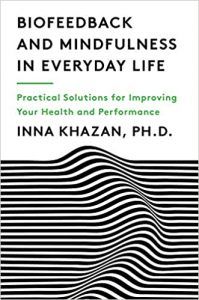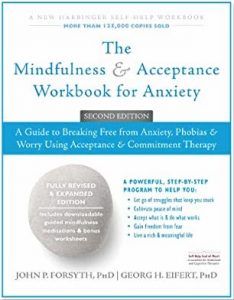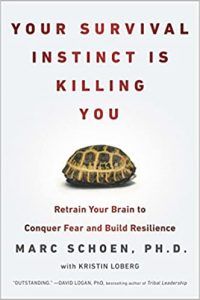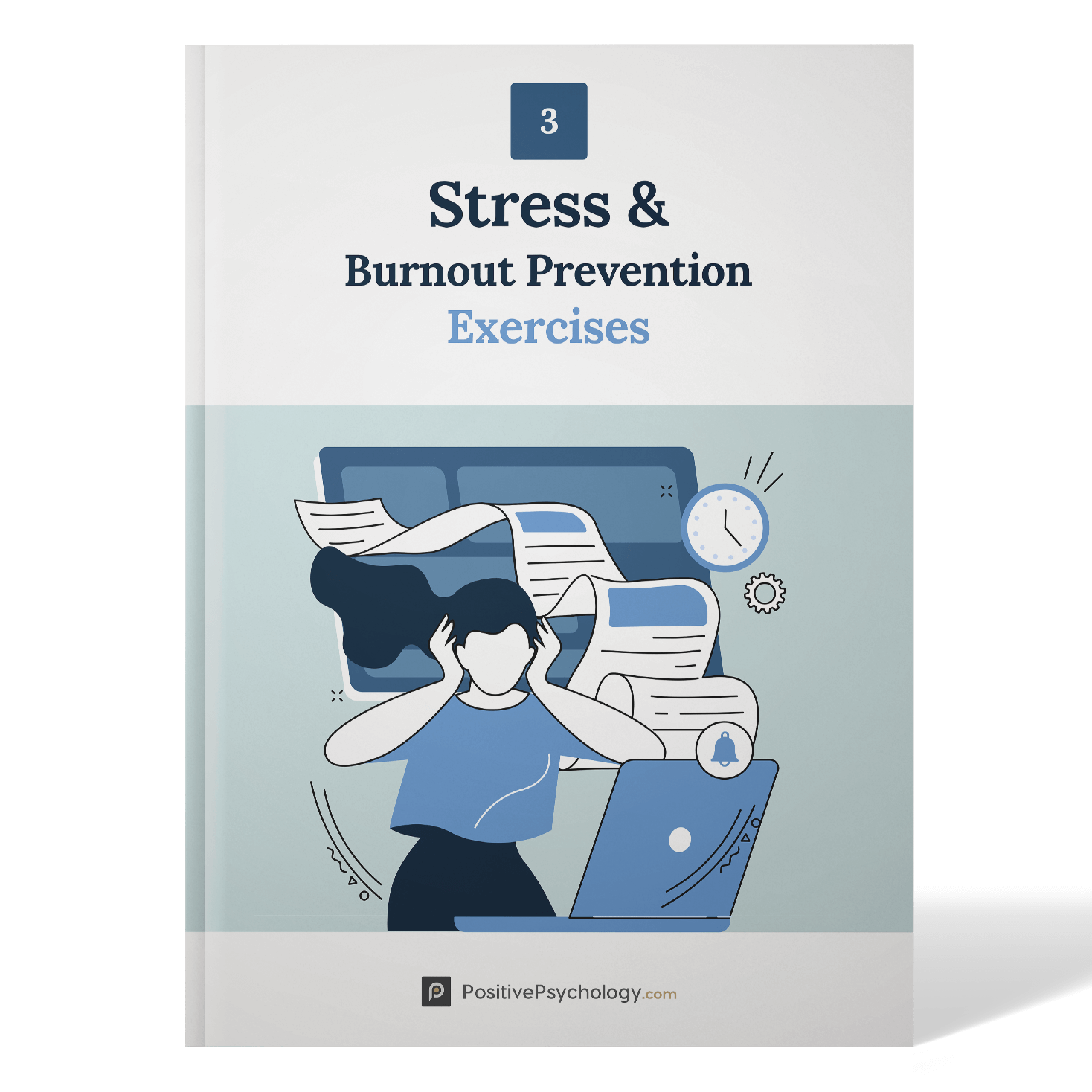The Fight-or-Flight Response: Everything You Need to Know
 Our fight-or-flight response has been shaped by millions of years of evolution over countless generations.
Our fight-or-flight response has been shaped by millions of years of evolution over countless generations.
It served us well for most of that time, readying us for attack and helping us escape when we encountered something dangerous (Schoen, 2014).
Now, in the largely ‘safe’ yet unduly stimulating world in which most of us live, our overly reactive survival instinct can lead to inappropriate, unwanted, and prolonged stress responses that ultimately harm our physical and mental wellbeing.
The tools and worksheets in this article help us manage and regain control over our fight-or-flight response and instead use it more positively and productively.
Before you continue, we thought you might like to download our three Stress & Burnout Prevention Exercises (PDF) for free. These science-based exercises will equip you and your clients with tools to better manage stress and find a healthier balance in your life.
This Article Contains:
- What Is the Fight, Flight, or Freeze Response?
- 4 Psychology Examples of the Response
- Understanding Its Role in Anxiety and Stress
- How to Manage the Response
- 6 Worksheets, Handouts, and Meditation Ideas
- 3 Books About the Fight-or-Flight Theory
- Resources From PositivePsychology.com
- A Take-Home Message
- References
What Is the Fight, Flight, or Freeze Response?
Our need to survive has shaped how we respond to the environment and the threats we face. Our fight, flight, and freeze responses help us to face up to perceived threats, run away, or stop moving. The freeze response “involves being rendered immobile when confronted with a potential threat” with fight and flight on hold (McCabe & Milosevic, 2015, p. 180).
For much of our 21st-century life, fight and flight responses are becoming less helpful, albeit still common. According to Harvard Health Publishing (2020), chronic activation of this survival mechanism is commonplace and damaging to our physical and mental wellness.
Science has long known that long-term chronic stress – the repeated activation of the stress response – takes a profound toll on psychological and physical health, both directly and indirectly, with some of the following results (Harvard Health Publishing, 2020; Khazan, 2019):
- High blood pressure
- Formation of artery-clogging deposits
- Anxiety
- Depression
- Addiction
- Obesity
- Poor sleep
- Overbreathing (breathing out too much carbon dioxide)
Parasympathetic and sympathetic nervous systems
Here’s an example: when we realize we have stepped in front of an oncoming car, information from our eyes and ears arrives at the amygdala, where images and sounds are processed. The amygdala also contributes to emotional processing, sending distress signals to the hypothalamus.
From here, messages are sent to the rest of the body through the autonomic nervous system, made up of the parasympathetic and sympathetic systems, and we respond by choosing to fight, run, or freeze (Harvard Health Publishing, 2020).
The sympathetic nervous system provides the body with the burst of energy needed to take action in response to the perceived threat. On the other hand, the parasympathetic nervous system kicks in when the danger has passed, calming the body when it’s safe to do so.
10+ Symptoms of the response
When the hypothalamus sends its distress signal through the autonomic nerves to the adrenal glands, the hormone epinephrine (adrenaline) is pumped into the bloodstream, resulting in the following (Harvard Health Publishing, 2020; Nunez, 2020):
- Heartbeat speeds up, pushing more blood and oxygen to the muscles and other vital organs. During a freeze response, heart rate may slow.
- Pulse and blood pressure increase.
- Breathing speeds up to get more oxygen into the blood. During a freeze response, breathing may be interrupted or restricted.
- Small airways in the lungs open wide.
- Increased oxygen to the brain leads to increased alertness and sharpened senses.
- Pupils may dilate to let in additional light, and hearing improves.
- More blood sugar (glucose) and fats are released into the bloodstream to supply extra energy.
- Ongoing perception of threat leads to further release of adrenaline and cortisol.
- Skin may get cold or sweat, as can hands and feet.
- Pain perception may reduce.
Once the perceived threat is over, the parasympathetic system begins to dampen the stress response.
4 Psychology Examples of the Response

This fear results from conditioning, when an event or object has been associated with a negative experience.
When you encounter a perceived threat, your brain thinks you are in danger and attempts to keep you safe through a fight-flight-freeze response. Sometimes, it is lifesaving; other times, it is incorrect or a poor match for the situation, for example:
- Hearing a loud noise in the middle of the night
- Jumping out of the way of a speeding vehicle
- Feeling scared when walking down a dark alley
- Being asked to give an impromptu speech
Some of these responses are overactive. A non-threatening situation triggering a fight, flight, or freeze reaction can result from previous trauma or existing anxiety (Nunez, 2020).
The following psychological threat examples may not result from the object or event itself (e.g., public speaking, social situations, or spiders) but from being afraid of the experience of anxiety associated with it (McCabe & Milosevic, 2015):
- Panic attacks
Panic attacks can be part of the fear response in anxiety disorders and are sometimes associated with anxiety over losing control, dying, or “going crazy.” They can occur in threat-free situations. - Anxiety sensitivity
The fear of fear can result from the belief that the sensations (e.g., racing heart, rapid breathing, and sweating) signal imminent physical, psychological, and social harm. - Agliophobia
Agliophobia is the fear of pain or suffering in the short or long term. This condition can lead to extreme reactions, such as escaping or avoiding situations with even the slightest chance of injury. It is less about the pain itself and more about its anticipation (for example, a fear of needles). - Social anxiety disorder
This involves the fear of being judged or evaluated in social or performance situations, such as during interviews or when presenting. The anxiety or avoidance behavior associated with this fear can significantly impair quality of life.
The event itself is less important than the individual’s perception, impacted by knowledge, experiences, and expectations.
Understanding Its Role in Anxiety and Stress
Ideally, the fight-or-flight response would only occur when necessary or helpful. The sympathetic nervous system stimulates the body’s action, and then the parasympathetic nervous system returns the body to rest (Sperber, n.d.).
When there is a repeated and prolonged sense of danger, individuals experience it as ongoing stress and risk developing chronic anxiety, mood disorders, depression, immune system suppression, and difficulty sleeping, all of which can further aggravate an already overly sensitive and dysregulated fight-or-flight system (Gillespie, Phifer, Bradley, & Ressler, 2009; McCabe & Milosevic, 2015).
How to Manage the Response

There are many practical things we can do, including the following (Schoen, 2014; Khazan, 2019; Sperber, n.d.; Nunez, 2020):
Relaxation techniques
Engage the parasympathetic nervous system and use relaxation techniques to counteract the stress response. For example:
- Learning breathing skills can stimulate the vagus nerve and the sympathetic nervous system, reducing stress and encouraging calm (Nestor, 2020).
- Use mindfulness and meditation techniques to help focus on the now, relieve existing feelings of panic and stress, and take that feeling of peace into the day.
- Visualization is a powerful tool for expressing how we feel, achieving calm, and working through situations that cause emotional discomfort.
Physical activity
Regular exercise is a powerful tool for resetting our stress response by:
- Reducing stress hormones, including adrenaline and cortisol
- Increasing endorphins that promote a state of calm
- Improving sleep, essential for keeping both body and mind in balance
Social support
Positive relationships promote individual wellbeing and better stress management.
- Social support groups can be a valuable way to share emotions, feelings, and coping mechanisms.
- Taking time out with friends to talk about the issues we face can reduce our overall stress and reactivity levels.
There are many ways to cope with stress and manage our survival response. The best strategies and techniques are the ones that fit our lifestyle, suit our personality, and provide us with confidence that we can manage an existing or future situation.
6 Worksheets, Handouts, and Meditation Ideas
The following tools are some of our favorites for managing the fight-or-flight response and the stress, anxiety, and panic that can follow. Try them out and feel free to personalize them to your own needs (modified from Schoen, 2014; Khazan, 2019; Forsyth & Eifert, 2016).
Responding With Fear and Worry
While our responses can seem automatic and outside our control, it is valuable to revisit and reflect on them to understand if they are helpful and appropriate. Fight and flight responses developed to answer a need and still, at times, remain crucial for survival.
The Responding With Fear and Worry worksheet explores a time when you or someone close to you experienced real danger, then asks you to consider whether or not your response was helpful. Recognizing that, at times, a rash, automatic response may be the right one helps us reduce our fear of being unable to handle situations.
Signs of Emotional Discomfort
When stressed and agitated, we may be more likely to react quickly and without thinking things through. However, the chronic discomfort that often preempts rash thinking rarely appears out of the blue. With practice, we can see it coming (Schoen, 2014).
Use the Signs of Emotional Discomfort worksheet to spot the signals that suggest we are becoming more agitated and responding poorly to life events (modified from Schoen, 2014).
Breaking Out of the Comfort Zone
While it may seem that remaining in our comfort zone will protect us from discomfort, there is a risk that its perimeters will start to shrink. Rather than residing in our area of familiarity, it is important to create a degree of discomfort (Schoen, 2014).
Use the Breaking Out of the Comfort Zone worksheet to identify opportunities to challenge our comfort zone.
At a micro-level, simply reading a book, listening to music, or going to a play that challenges you can break you out of your comfort zone and make you more ready to deal with the unfamiliar or unexpected.
Funeral Meditation
The way we react to life events may hold us back, causing us to avoid the opportunities we have and not take the chances that arise.
The Funeral Meditation worksheet is less morbid than it would first seem. Rather than boosting anxiety regarding our limited time on this planet, this powerful meditation helps us reflect on what matters to us.
The good news is you still have time to change who you are. “You can start living the way you want to be remembered later on” (Forsyth & Eifert, 2016, p. 115).
Finding Fresh Alternatives
Even though the impulse to act may be an automatic response, the action is not inevitable. The gap between impulse and action gives you time to determine how you would like to respond.
The Finding Fresh Alternatives worksheet identifies events and situations where your impulse to act on your worries, anxieties, and fears was strong, then asks you to reflect on how you responded.
You have control over how you react to your impulses and how you behave, no matter how strong they are.
Stop Right Now
Automatic responses can be unhelpful. Unless we are in a dangerous situation, fighting or fleeing may not be the best way to react. It can be valuable to have a set of questions nearby to challenge what we are about to do.
Use the Stop Right Now worksheet to stop before you react and consider whether you should act on your intention.
In time and with practice, these questions can be internalized and become automatic. They can help you notice, experience, and learn rather than unthinkingly react.
3 Books About the Fight-or-Flight Theory
The following books explore the fight-or-flight response and related issues such as anxiety, fear, stress, and how to handle them.
1. Biofeedback and Mindfulness in Everyday Life: Practical Solutions for Improving Your Health and Performance – Inna Khazan

This is a valuable and practical book with many techniques for applying the mind–body approach to an array of common problems.
Find the book on Amazon.
2. Your Survival Instinct Is Killing You: Retrain Your Brain to Conquer Fear and Build Resilience – Marc Schoen
Marc Schoen shares how the many mild discomforts in our otherwise comfortable 21st-century life can still trigger ancient fight-or-flight responses.
There are ways to regain control and tame your overly reactive survival instinct and improve every aspect of your life.
Find the book on Amazon.
3. The Mindfulness and Acceptance Workbook for Anxiety: A Guide to Breaking Free From Anxiety, Phobias and Worry Using Acceptance and Commitment Therapy – John Forsyth and Georg Eifert

The authors have created a valuable resource for anyone struggling with anxiety and fear through nurturing the capacity for acceptance, kindness, and compassion.
Find the book on Amazon.
Resources From PositivePsychology.com
The fight-or-flight response is closely aligned with how we react to stressful events and situations.
Why not download our free stress tool pack and try out the powerful tools contained within? Here are some examples:
- Energy Management Audit
This worksheet offers insights into the client’s energy strengths and deficits and is valuable for balancing the many competing demands they face. - Stress-Related Growth Scale
This is a helpful questionnaire for understanding an individual’s perceived positive outcomes of a stressful or traumatic event.
Other free resources include:
- Squeeze and Release
This valuable group activity encourages participants to experience stress in a positive form, helping them discover its potential for energizing and coping. - Radical Acceptance of a Distressing Situation
These 11 questions help the client look at distressing situations in an alternative, more positive way.
More extensive versions of the following tools are available with a subscription to the Positive Psychology Toolkit©, but they are described briefly below:
- Stress Management Emergency Plan
This framework identifies four different types of stressors and connects them to client-generated coping skills:
-
- Time stress – lack of time to complete what is required to the standard expected.
- Anticipatory stress – related to events that are yet to occur.
- Situational stress – when you face a situation over which you have no control.
- Encounter stress – brought on by other, often challenging, people.
Use the tool to create a stress management emergency plan and identify triggers and coping skills.
- The Yes-Brain Versus the No-Brain
A yes-brain mindset can cultivate psychological wellbeing.
This experiential exercise illustrates the difference between the two mindsets by examining our reactions when we say the words “yes” and “no.”
-
- ‘No’ – Notice the feelings that arise
- ‘Yes’ – Identify what arises in the body when you change your response.
The user then reflects on how the two answers made them feel before exploring the different mindsets and how a ‘yes’ brain can lead to greater balance, resilience, insight, and empathy.
- 17 Stress & Burnout Prevention Exercises
If you’re looking for more science-based ways to help others manage stress without spending hours on research and session prep, check out this collection of 17 validated stress management tools for practitioners. Use them to help others identify signs of burnout and create more balance in their lives.
A Take-Home Message
We have many built-in and fast-reacting mechanisms within the brain. They have kept us safe for thousands of generations. While they still have great value sometimes, they can also cause us considerable mental and physical harm when operating inappropriately.
Our fight, flight, and freeze responses can leave us chronically activated, resulting in mental and physical ailments, such as high blood pressure, poor sleep, weight gain, anxiety, depression, and mood disorders.
Reducing background levels of activation through improved breathing and mindfulness techniques and maintaining good physical health are valuable. Revisiting situations when our survival response was either valid and helpful or inappropriate and harmful can help us recognize its value and need to be managed.
This article introduces the psychological and physiological factors involved in the fight-or-flight response and offers techniques to manage, avoid, and regain control of the situation. We must recognize that aspects of how we react to the environment offer insight into our evolutionary past while allowing for better handling of our present.
We hope you enjoyed reading this article. Don’t forget to download our three Stress & Burnout Prevention Exercises (PDF) for free.
- Forsyth, J. P., & Eifert, G. H. (2016). The mindfulness & acceptance workbook for anxiety: A guide to breaking free from anxiety, phobias & worry using acceptance & commitment therapy. New Harbinger Publications.
- Gillespie, C. F., Phifer, J., Bradley, B., & Ressler, K. J. (2009). Risk and resilience: Genetic and environmental influences on development of the stress response. Depression and Anxiety, 26(11), 984–992.
- Harvard Health Publishing. (2020). Understanding the stress response. Retrieved November 22, 2021, from https://www.health.harvard.edu/staying-healthy/understanding-the-stress-response
- Khazan, I. Z. (2019). Biofeedback and mindfulness in everyday life: Practical solutions for improving your health and performance. W.W. Norton & Company.
- McCabe, R., & Milosevic, I. (2015). Phobias: The psychology of irrational fear. ABC-CLIO.
- Nestor, J. (2020). Breath: The new science of a lost art. Penguin Books.
- Nunez, K. (2020). Fight, flight, or freeze: How we respond to threats. Healthline. Retrieved November 22, 2021, from https://www.healthline.com/health/mental-health/fight-flight-freeze#overactive-response
- Schoen, M. (2014). Your survival instinct is killing you: Retrain your brain to conquer fear and build resilience. Plume.
- Sperber, S. (n.d.). Fight or flight response: Definition, symptoms, and examples. Berkeley Well-Being Institute. Retrieved November 23, 2021, from https://www.berkeleywellbeing.com/fight-or-flight.html
Read other articles by their category
- Body & Brain (41)
- Coaching & Application (49)
- Compassion (27)
- Counseling (46)
- Emotional Intelligence (23)
- Gratitude (16)
- Grief & Bereavement (19)
- Happiness & SWB (35)
- Meaning & Values (26)
- Meditation (21)
- Mindfulness (42)
- Motivation & Goals (42)
- Optimism & Mindset (33)
- Positive CBT (24)
- Positive Communication (21)
- Positive Education (41)
- Positive Emotions (28)
- Positive Psychology (33)
- Positive Workplace (38)
- Relationships (31)
- Resilience & Coping (33)
- Self Awareness (21)
- Self Esteem (38)
- Software & Apps (23)
- Strengths & Virtues (28)
- Stress & Burnout Prevention (27)
- Theory & Books (42)
- Therapy Exercises (30)
- Types of Therapy (53)




